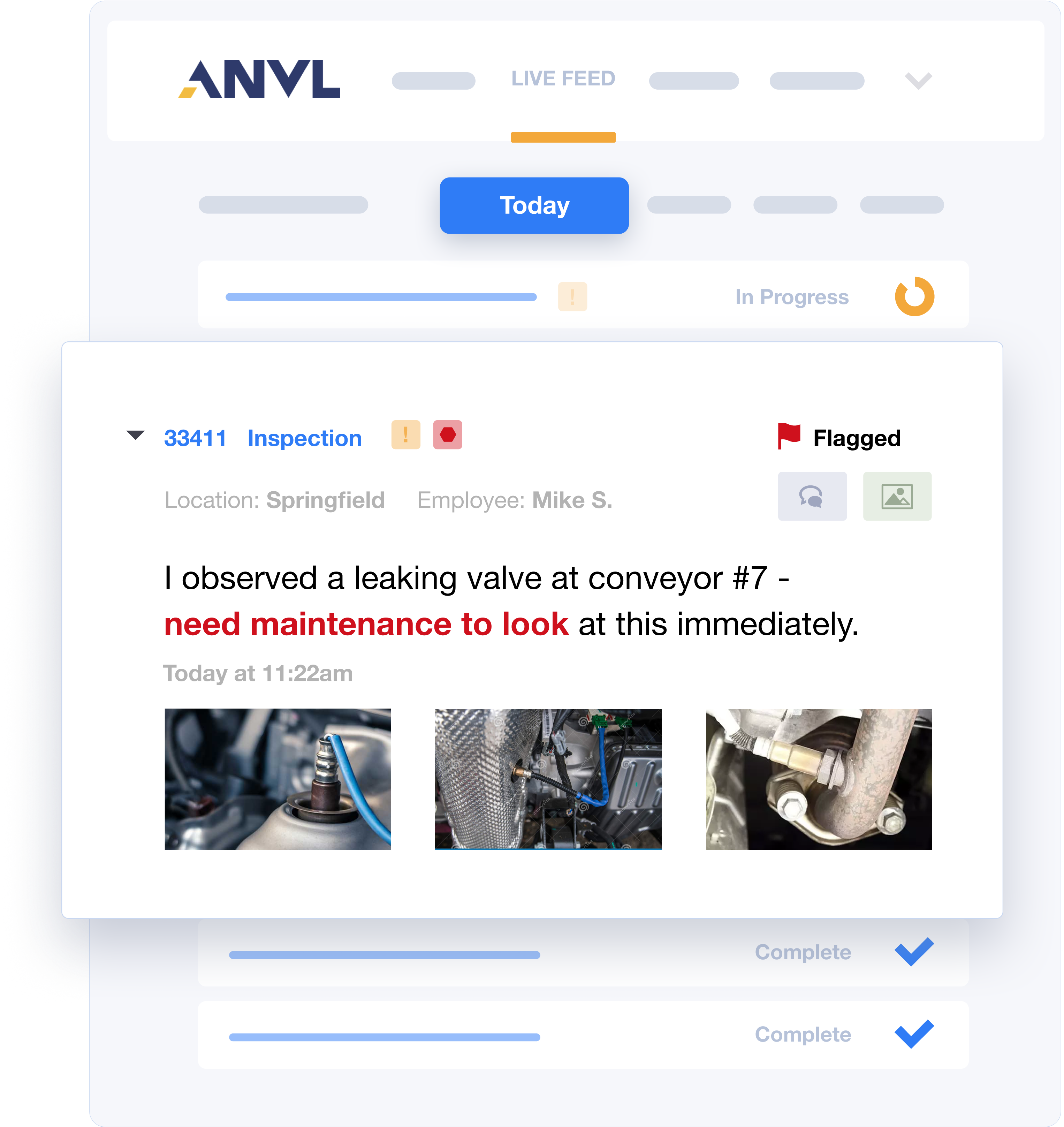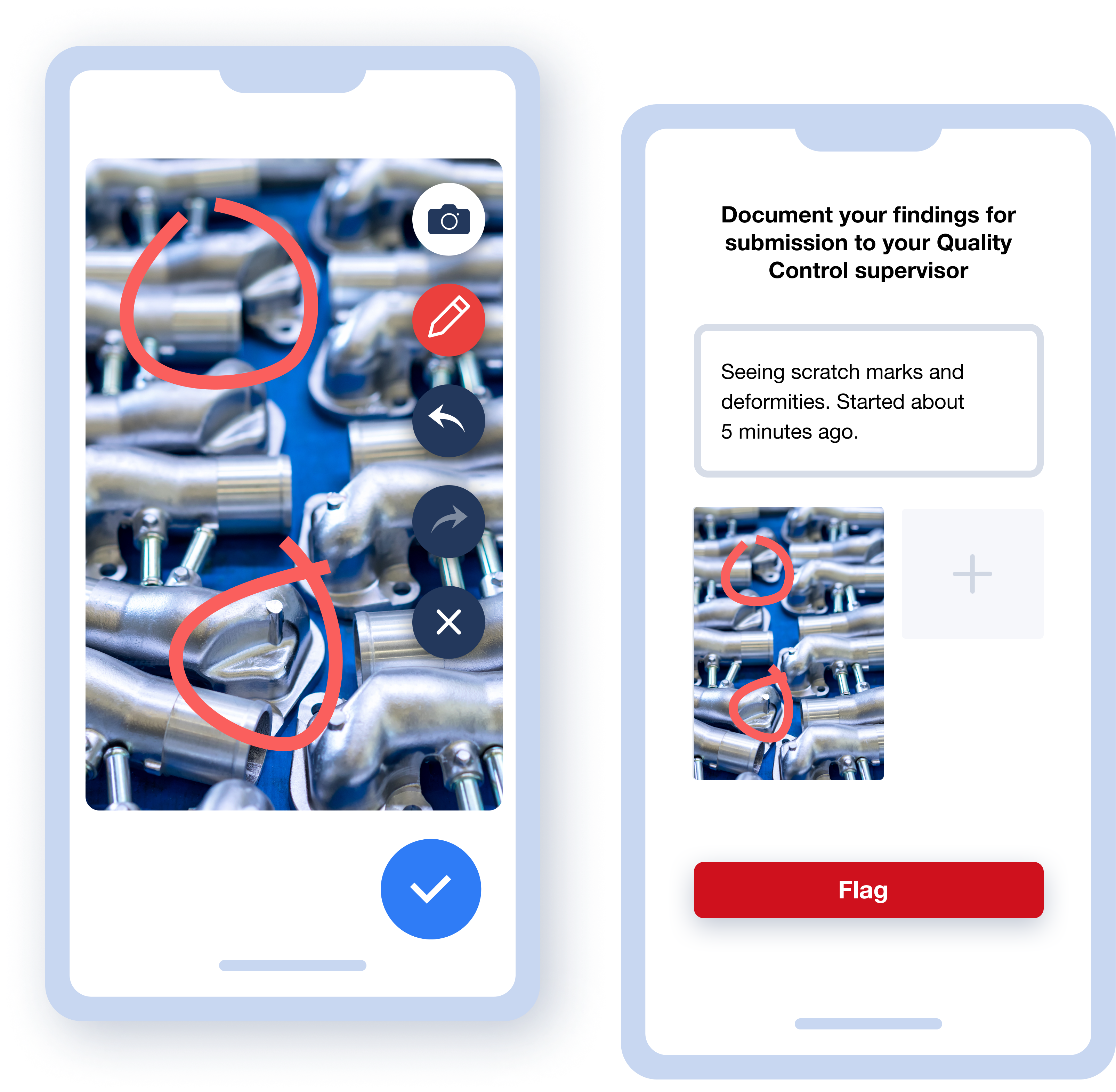Job Hazard Analysis Software
Reimagine Your Job Hazard Analysis
Anvl’s Job Hazard Analysis dynamic workflow capabilities take traditional safety programs to the next level.
Why wait for the data to be tabulated or analyzed?
Anvl engages users in real-time to capture critical data and provide reports that highlight what matters most. You don’t need to wait for forms to be turned in and collected in order to identify hazards or risks. Make worker safety an actionable, proactive approach. With Anvl, you will be able to automate data collection and identify continuous improvements for safety.

To see if Anvl Job Hazard Analysis workflows are right for you, ask yourself these questions:
Do you know what the actual issues are?
Anvl’s dynamic workflows enable rich data capture that includes real-time photos, voice-to-text, and follow up questions to get to the core of the issue.
Your workers will capture critical data to eliminate manual data entry and tabulation – no more entering data in spreadsheet and losing critical information.
The Anvl mobile app is easy-to-use, and training only takes less than an hour, meaning users will be able to collect impactful, meaningful data immediately.
Data collection is automated and immediately available to leaders for viewing. Actionable reports allow you to identify trends happening in your JHA data.

Do you spend more time manually collecting data, or putting that data into action?
JHAs are often long checklists for workers to complete. With so many boxes, issues like pencil-whipping often occur, making hazards and risks more likely to be overlooked. To make sure valuable data is collected, an engaging solution like Anvl is necessary to implement.
Through in-the-moment guidance, Anvl can configure alerts that can notify managers when a JHA should more urgently be reviewed. This could mean stopping the job, escalating, and resolving risks in the moment.
We provide actionable data and valuable insights that you have never had before. Anvl workflows capture information for JHAs by types of information such as by site, division, severity level, and more — giving you insight into the real issues captured by your workers.

How do you leverage Job Hazard Analysis data to improve safety?
JHA data presents training opportunities or may uncover a misunderstanding of company safety policies.
Are you seeing recurring trends or steps missed by your workers? With Anvl, safety training doesn’t stop after onboarding. Ongoing training and engagement is an added benefit of our mobile Connected Worker Solution — promoting time and cost savings.
Safety improvements are centered around learning and improving. If you’re spending most of your time entering data, the opportunity to observe trends is lost. Uncover critical insights and add structure and dimension to the data you capture so you can learn from it.

What is a Job Hazard Analysis?
A job hazard analysis, also known as JHA, is a systematic process used to identify and evaluate potential hazards in the workplace. It involves breaking down each task into steps and assessing the associated risks. The purpose of a job hazard analysis is to prevent accidents and injuries by identifying potential hazards and implementing appropriate controls.
The job hazard analysis meaning is not just about identifying potential hazards but also about taking necessary precautions to prevent accidents and injuries. It provides a comprehensive understanding of the tasks performed in different industries and the associated risks.
What does that mean for my industry?
In the construction industry, job hazard analysis plays a crucial role in ensuring worker safety, as it helps identify safety risks such as falls, improper use of equipment, and exposure to hazardous materials. Similarly, in utilities, manufacturing, and field service industries, conducting job hazard analyses is essential to identify potential hazards specific to each industry and develop effective safety protocols to mitigate risks. By analyzing job tasks and identifying potential hazards, organizations can create a safer work environment and reduce the likelihood of workplace accidents and injuries.
Job Hazard Analysis – OSHA
Job hazard analysis is an essential process in ensuring workplace safety and compliance with OSHA regulations. OSHA, the Occupational Safety and Health Administration, mandates that employers conduct a job hazard analysis to identify potential risks and hazards associated with specific job tasks and activities. This analysis helps employers develop effective strategies to mitigate hazards, prevent accidents, and protect workers’ health and well-being.
According to OSHA requirements, the job hazard analysis must be documented using a standardized form, such as the OSHA Job Hazard Analysis Form, and should involve a thorough assessment of each job step, potential hazards, and recommended preventive measures. Employers can also utilize OSHA risk assessment templates to streamline the process and ensure compliance with regulatory guidelines.
By implementing job hazard analysis and adhering to OSHA job hazard analysis regulations, employers demonstrate their commitment to maintaining a safe and healthy work environment for their employees.
Job Hazard Analysis Steps
Job hazard analysis (JHA) is a crucial process in ensuring workplace safety and compliance with OSHA regulations. The first step in the procedure for initiating a JHA is to identify the specific job tasks and activities to be analyzed. This involves conducting a thorough evaluation of the work environment, including equipment, materials, and processes. By following these job hazard analysis steps, employers can reduce the risk of accidents and injuries.

Identify the specific job tasks and activities:
The first step in the JHA process is to identify the job tasks and activities that need to be analyzed. This can be done by observing and documenting the tasks performed by workers in a particular job role.

Evaluate the work environment:
Once the job tasks and activities have been identified, the next step is to evaluate the work environment. This includes assessing the equipment, materials, and processes involved in the job. It is important to consider any potential hazards that may be present, such as chemicals, machinery, or repetitive motions.

Identify potential hazards:
During the evaluation of the work environment, it is essential to identify potential hazards that could pose a risk to employees. This can include physical hazards, such as unguarded machinery or slippery floors, as well as chemical hazards, such as exposure to harmful substances.

Assess the level of risk:
After identifying potential hazards, the next step is to assess the level of risk associated with each hazard. This involves considering the severity of the potential injury or illness that could result from exposure to the hazard, as well as the likelihood of exposure.

Develop control measures:
Once the level of risk has been assessed, it is important to develop control measures to minimize or eliminate the hazards. This can include implementing engineering controls, such as installing safety guards on machinery, or administrative controls, such as providing training and guidance to employees.

Review and update regularly:
Finally, it is crucial to regularly review and update the JHA to ensure its effectiveness. Job tasks and workplace conditions may change over time, so it is important to keep the analysis up to date and make any necessary adjustments to control measures.
By following these job hazard analysis steps, employers can create a safer and healthier work environment for their employees. OSHA also emphasizes the importance of JHA in preventing workplace accidents and injuries, and employers should strive to comply with OSHA regulations and guidelines. Conducting a thorough JHA can help identify and eliminate hazards, reduce the risk of accidents, and ensure the well-being of employees.
Ready to get started with Anvl?
Anvl can dive deeper into information about trends that are automatically captured from the floor. Drive continuous improvements in your business with one platform that will provide the data-driven insights that matter most of all.
Let’s Get Started!
Latest News

Quality 4.0: Revolutionizing Industrial Industries for Sustainable Success
In the fast-paced and rapidly evolving landscape of modern industries, maintaining success and remaining competitive requires continuous adaptation and improvement. One of the most significant developments in recent years has been the emergence of Quality 4.0, a...

The Crucial Role of Accurate Metrics and Reporting in Ensuring Quality and Safety in Industrial Industries
In the industrial landscape, quality and safety are paramount concerns that directly impact the success, reputation, and sustainability of businesses. To effectively manage these aspects, accurate metrics and reporting play a pivotal role. Industrial industries...

Optimizing Efficiency in Safety: How The Anvl Connected Worker Safety Platform can Transform Industrial Industries
Effective worker safety practices and operational efficiency are crucial for the success of any organization, especially in industrial industries. With numerous challenges and potential risks involved in these sectors, companies must prioritize the well-being of their...
